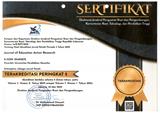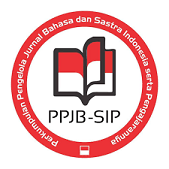ANALISIS MAJAS DALAM NASKAH DRAMA HASIL KONVERSI TEKS CERPEN SISWA KELAS XI BAHASA DAN BUDAYA SMA NEGERI 4 SINGARAJA
DOI:
https://doi.org/10.23887/jjpbs.v3i1.5294Abstrak
Penelitian ini bertujuan untuk (1) menjelaskan kemampuan siswa kelas XI Bahasa dan Budaya SMA Negeri 4 Singaraja dalam mengonversi teks cerpen menjadi naskah drama dan (2) mendeskripsikan jenis-jenis majas dalam naskah drama hasil konversi teks cerpen siswa. Subjek pada penelitian ini adalah siswa kelas XI Bahasa dan Budaya SMA Negeri 4 Singaraja. Objek penelitian ini adalah majas dalam 33 naskah drama hasil konversi teks cerpen siswa. Metode pengumpulan data yang digunakan adalah metode dokumentasi naskah drama hasil konversi teks cerpen. Penelitian ini menggunakan instrument wawancara untuk mengetahui pemahaman siswa terhadap naskah drama yang dibuat dan kartu data untuk membantu menganalisis majas yang digunakan. Data dianalisis dengan menggunakan teknik deskriptif kualitatif. Hasil penelitian ini adalah (1) beberapa siswa belum konsisten dalam pemberian nama tokoh dan alur pada naskah drama hasil konversi teks cerpen dan (2) ada 14 jenis majas yang ditemukan dalam naskah drama hasil konversi teks cerpen siswa kelas XI Bahasa dan Budaya SMA Negeri 4 Singaraja, yakni majas antisipasi, majas hiperbola, majas personifikasi, majas ironi, majas klimaks, majas tautotes, majas inuendo, majas sinisme, majas sinekdoke totem pro parte, majas epitet, majas antonomasia, majas perumpamaan/simile, majas perifrasis, majas satire. Di antara ke-14 majas tersebut, majas yang paling dominan digunakan adalah majas hiperbola dan personifikasi. Peneliti berharap peneliti lain dapat melakukan penelitian yang berkaitan dengan kegiatan mengonversi seperti menemukan konflik sosial budaya pada naskah drama hasil konversi siswa.Kata Kunci : cerpen, drama, majas, mengonversi
This study aimed to (1) to explain the students’ ability of XI Bahasa dan Budaya’s students SMAN 4 Singaraja in conversioning short story become drama’s script (2) to description the kinds of figure of speech in drama’s script from the result of conversioning short story of the students’. The subjects of this research were the students’ of XI Bahasa dan Budaya SMAN4 Singaraja. The object of this research was the result of conversion figure of speech by students’ in 33 drama’s script. The method of data collection used in this research was documentation of drama’s script that the result of conversion the text of short story. The instrument of this research was interview used to know the students’ comprehension from drama’s script that had been created and data card to help for analyzing the kinds of figure of speech. The data was analyze by using descriptive qualitative. Results of this study were (1) some students have not been consistent in giving the name of the character and grouve plays short story text conversion result and (2) there are 14 kinds of figure of speech in the converted text plays short story class XI student of Bahasa dan Budaya SMAN 4 Singaraja, the anticipated figure of speech, figure of speech hyperbole, personification figure of speech, figure of speech irony, figure of speech climax, tautotes figure of speech, figure of speech innuendo, figure of speech cynicism, totem figure of speech sinekdoke pro parte, figure of speech epithet, figure of speech antonomasia, figure of speech metaphor/simile, perifrasis figure of speech, satire figure of speech. Among the 14 figure of speech, the most figure of speech used it hyperbola and personification figure of speech. Researching hope that other reseachers can conduct research related to the converting activities like finding socio cultural conflics in student plays the convertion result.
keyword : short story, drama, figure of speech, conversioning
Diterbitkan
2015-07-22
Terbitan
Bagian
Articles
Lisensi
Authors who publish with the Jurnal Pendidikan Bahasa dan Sastra Indonesia Undiksha agree to the following terms:- Authors retain copyright and grant the journal the right of first publication with the work simultaneously licensed under a Creative Commons Attribution License (CC BY-SA 4.0) that allows others to share the work with an acknowledgment of the work's authorship and initial publication in this journal
- Authors are able to enter into separate, additional contractual arrangements for the non-exclusive distribution of the journal's published version of the work (e.g., post it to an institutional repository or publish it in a book), with an acknowledgment of its initial publication in this journal.
- Authors are permitted and encouraged to post their work online (e.g., in institutional repositories or on their website) prior to and during the submission process, as it can lead to productive exchanges, as well as earlier and greater citation of published work. (See The Effect of Open Access)







